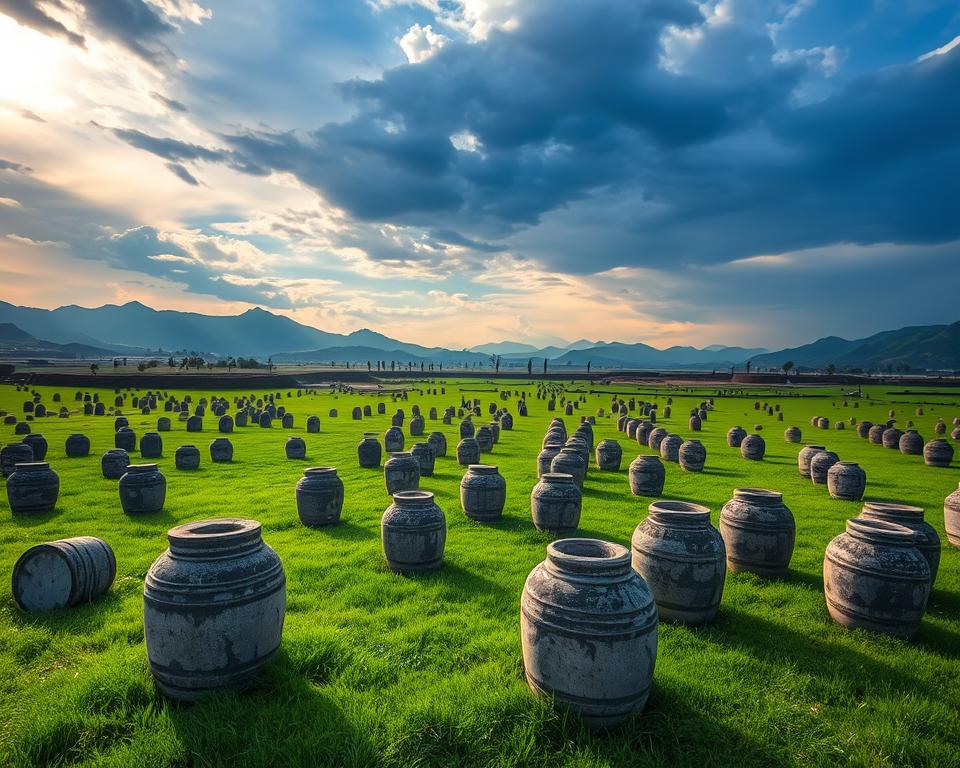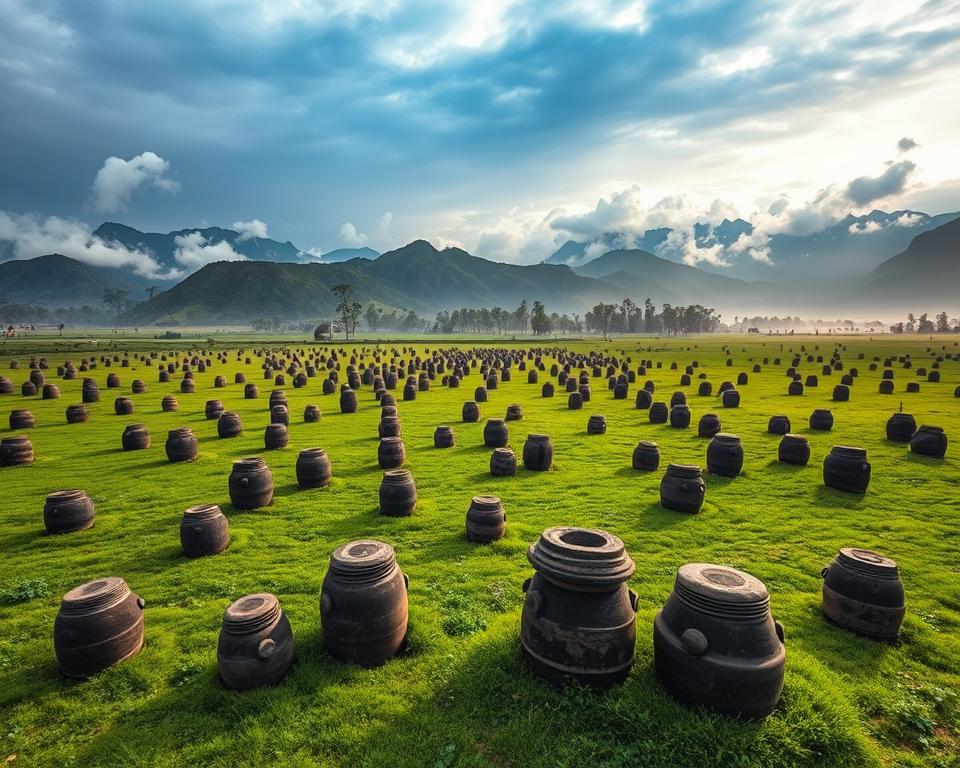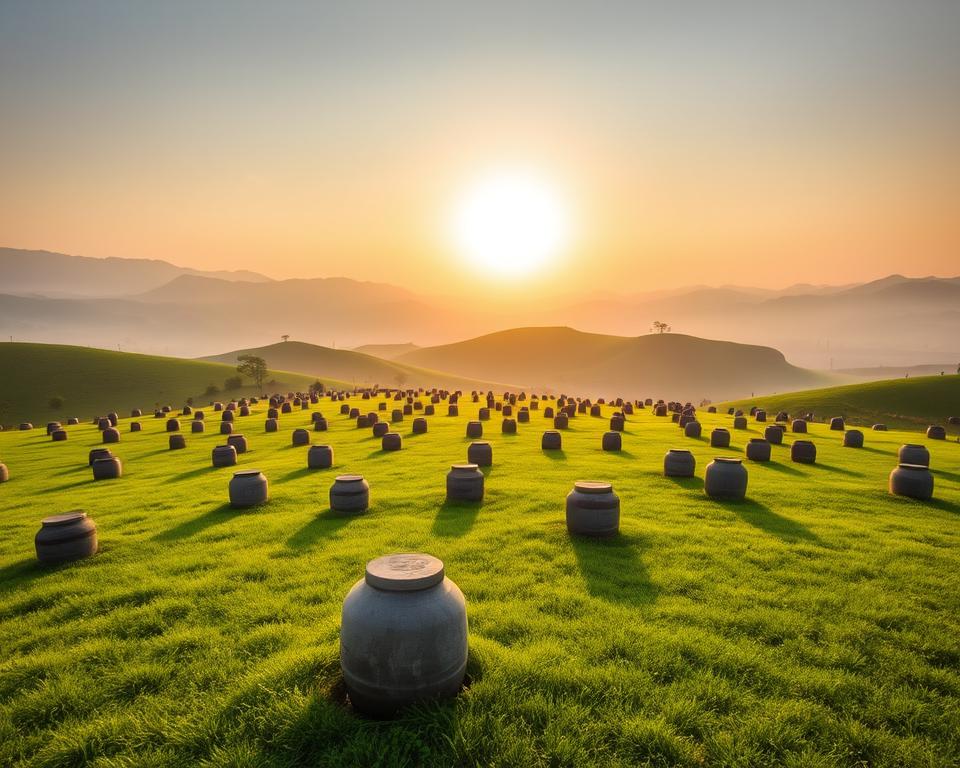The Plain of Jars in Laos is a fascinating site that has captured the hearts of many. It’s a UNESCO World Heritage site filled with ancient stone jars. These jars are spread out across the landscape, each telling a unique story from the past.
The site is in the Xieng Khouang province. It’s a remarkable place that gives us a peek into the lives of ancient civilizations in Southeast Asia.
Read interesting things at : warlockgroup
Key Takeaways
- The Plain of Jars is a UNESCO World Heritage site in Laos featuring thousands of ancient stone jars scattered across the landscape.
- The jars are believed to be remnants of prehistoric funeral practices, though their exact origins and purpose remain a mystery.
- Exploring the Jar Fields offers a unique opportunity to delve into the rich cultural heritage and forgotten civilizations of Southeast Asia.
- The site’s remote location and history of unexploded ordnance pose challenges for visitors, but also add to the sense of adventure and discovery.
- Ongoing conservation efforts aim to preserve the Plain of Jars for future generations, while respecting the sacred nature of the site.
The Plain of Jars: A Megalithic Archaeological Wonder
In Laos’ Xieng Khouang province, the Plain of Jars is a site unlike any other. It’s filled with thousands of stone jars, each weighing tons. These jars are thought to be from an ancient funeral practice.
The plain of jars, a megalithic archaeological site, fascinates everyone who visits. People are drawn to the jar fields‘ secrets and the stone jars of Xieng Khouang.
Uncovering the Ancient Secrets of the Jar Fields
The plain of jars has been a mystery for years. Archaeologists are still trying to figure out why these huge jars were made. They also want to know who made them.
By studying the monumental stonework, researchers hope to learn more. They aim to understand the lives and customs of ancient people in the area.
Exploring Xieng Khouang’s Enigmatic Stone Vessels
The stone jars at the Plain of Jars vary in shape and size. Some are simple, while others are intricately carved. Others seem damaged or broken.
Visitors can walk through the jar fields. They can see the massive jars and wonder about the people who made them.
“The Plain of Jars is a truly remarkable and enigmatic site, offering a tantalizing glimpse into the past and the lost civilizations of Southeast Asia.”
A Journey Through Laos’ UNESCO World Heritage Site
Lao’s heart beats with a treasure trove of ancient wonders – the enigmatic Plain of Jars. This site was named a UNESCO World Heritage site in 2019. It shows its deep historical and cultural value.
In Xieng Khouang province, visitors can explore the vast jar fields. Thousands of ancient stone vessels sit here, their origins and purpose unknown. These structures show the skill and ingenuity of the region’s ancient people.
“Exploring the Plain of Jars is like stepping back in time, where the echoes of a forgotten civilization whisper from each weathered stone.”
Walking through the jar fields takes you back in time. The past and present meet in a mix of wonder and mystery. The UNESCO status means this cultural gem will be kept safe for future generations. It invites travelers to uncover the secrets of the plain of jars.
The scale of the stone vessels and the views around them make a trip to the Plain of Jars unforgettable. Visitors leave with a sense of wonder and a deeper respect for the ancient people of Laos.
Unraveling the Prehistoric Funeral Practices
The plain of jars in Laos has fascinated many. These stonework structures are thought to be linked to ancient funeral practices of a prehistoric civilization.
Experts believe the stone jars were part of a burial ritual. The deceased were first placed inside the jars. Then, their remains were moved to other burial sites. This shows the ancient people’s deep understanding of death and the afterlife.
Theories on the Origins of the Monumental Stonework
The purpose of the monumental stonework at the Plain of Jars is still debated. Some think the jars were burial urns. Others believe they stored food or offerings during funerals.
- One idea is that the jars held the deceased during a multi-stage burial.
- Another theory is that they stored bones after the initial exposure.
- A third theory suggests they were for fermenting rice wine or other drinks in rituals.
Despite many theories, the true purpose of the ancient funeral practices at the Plain of Jars is still a mystery. More research is needed to uncover its secrets.
The Plain of Jars: A Glimpse into Southeast Asia’s Forgotten Civilization
The plain of jars in Laos’s Xieng Khouang plateau is a mystery. These stone jars, some as tall as six feet, hint at a prehistoric civilization in Southeast Asia. They show us a part of history that was once unknown.
Scientists are still trying to figure out why these stone jars were made. They wonder who built them and what they were for. The jars give us hints about how people lived and died long ago.
Studies show the jars were part of burial rituals. They held human remains and other important items. This shows the ancient people had a deep understanding of death and the afterlife.
The plain of jars covers a large area, showing the complexity of the ancient culture. The fact that they built such big structures without modern tools is amazing. It makes us want to learn more about this southeast asian history.
“The plain of jars is a remarkable and enigmatic archaeological site that offers a tantalizing glimpse into the forgotten past of Southeast Asia. These stone vessels, scattered across the Xieng Khouang plateau, are a testament to the ingenuity and social sophistication of the prehistoric civilization that once thrived in this region.”
Navigating the Jar Fields: A Visitor’s Guide
Exploring the plain of jars in Xieng Khouang, Laos, is an adventure. It’s perfect for those who love history, archaeology, or the mystery of these stone vessels. This guide will help you make the most of your visit.
Best Times to Visit and What to Expect
The plain of jars in Xieng Khouang is open all year. The best time to go depends on what you like and the weather. The dry season, from November to April, is cooler and drier, great for exploring.
During the wet season, from May to October, the area is green and sometimes rainy. It’s a different view but still beautiful.
Visitors are always amazed by the plain of jars. There are thousands of stone jars, some over 6 feet tall. They are spread out over hills and valleys, showing us a lost civilization.
Be ready for uneven ground. The jar fields can be tough to walk on, especially in remote spots. Always listen to local guides or follow signs to stay safe and respect the site.
| Best Time to Visit | What to Expect |
|---|---|
| Dry Season (November to April) | Cooler temperatures, less rainfall, easier navigation |
| Wet Season (May to October) | Lush, green landscapes, occasional showers, more challenging terrain |
“The plain of jars is a profound and captivating archaeological site that offers visitors a unique opportunity to step back in time and explore the mysteries of an ancient civilization.”
The Enigma of the Plain of Jars’ Stone Vessels
The plain of jars, a megalithic archaeological site in Laos, is famous for its mysterious stone jars. These huge, enigmatic vessels, some weighing several tons, have sparked endless study and debate. Scholars are trying to figure out who made them and why.
The size of these stone jars is truly awe-inspiring. They range from a few feet to over six feet tall. It’s believed they were used in ancient funeral rites, possibly to hold the dead. But, the true purpose behind them is still a mystery, with many theories floating around.
The stone jars also fascinate visitors with their mysterious origins. Though it’s known they were made during the Iron Age, who built them and why is still unknown. Many expeditions and studies have tried to uncover the truth, but the site’s secrets remain hidden.
Despite the mystery, the plain of jars is a must-see for history and culture enthusiasts. Its massive size and the enigma of the stone jars make it a standout attraction in Southeast Asia. It’s a place where history and mystery come together in a fascinating way.

“The plain of jars is a truly remarkable and perplexing site, a testament to the ingenuity and creativity of our ancestors. Despite the passage of time, these stone jars continue to captivate and intrigue us, inviting us to unlock the secrets of the past.”
Preserving the Past: Conservation Efforts at the Site
The Plain of Jars, a UNESCO World Heritage site in Laos, is full of mystery. It has thousands of stone vessels that have puzzled scholars and visitors for years. Saving this cultural treasure is very important. Local and international groups are working hard to protect it for the future.
The Lao Department of Heritage is leading the way in saving the Plain of Jars. They work with UNESCO and others to keep the site safe. Their work includes:
- Mapping the jars to understand their layout and condition.
- Cleaning the site to stop the jars from getting worse.
- Protecting the site from vandalism and theft.
- Teaching locals about the site’s value and getting them involved in its care.
Groups like the World Monuments Fund also help. They work with Lao officials to plan for the site’s future. Their plans include managing tourism, protecting the environment, and working with the community.
“The Plain of Jars is a tangible link to Laos’ rich cultural heritage, and its protection is crucial for preserving the country’s unique identity and history.”
As more people visit the Plain of Jars, saving it is more important than ever. The ongoing efforts are key to keeping this UNESCO World Heritage site safe. They help us learn more about Laos’ past.
Exploring the Myths and Legends of the Jar Fields
The plain of jars in Laos is full of local folklore and superstitions. For ages, the stone vessels have sparked the Lao people’s curiosity. They have woven a rich tapestry of myths and legends that show the area’s culture and spirituality.
One legend says an ancient king had a grand feast. He used the jars to store rice wine for his guests. After the party, the king and his people were turned to stone, leaving behind a haunting reminder of their celebration.
Another story tells of giants who built the jars. These giants were said to have buried their fallen comrades in the jars. This kept the memory of their ancestors alive.
The plain of jars is also filled with superstitions. Some believe the jars have magical powers. It’s thought to be unlucky to disturb or move them. Local tales warn of bad luck or supernatural punishment for those who do.
Discovering the myths and legends of the plain of jars gives us a peek into Laos’ cultural and spiritual past. These stories not only amaze but also offer deep insights into this mysterious archaeological site.
“The jars have been the subject of speculation and mystery for centuries, with local legends and superstitions adding to the aura of enchantment that surrounds this ancient site.”
The Scientific Quest to Unlock the Jars’ Secrets
The plain of jars in Laos has always fascinated archaeologists and historians. People from all over have joined in to study these stone vessels. They aim to uncover the secrets behind these ancient jars.
Scientists are trying to figure out where the jars came from and why they were made. They use a method called carbon dating to learn about the jars’ past. This helps them understand the old funeral customs and traditions of the people who built these structures.
Geospatial analysis and new imaging tools are also key in this research. By mapping the jars, scientists find patterns. These patterns help them understand how the site changed over time and its links to other ancient places in Southeast Asia.

Working with local communities is also important. They share stories and knowledge passed down through generations. This helps researchers see the jars in the context of Laos’ rich culture.
The search for answers about the jars is ongoing. Everyone is excited to see what new discoveries will reveal. These findings could shed more light on the mysteries of the plain of jars.
Responsible Tourism: Respecting the Sacred Site
The plain of jars in Laos is a UNESCO World Heritage site. It needs careful care and responsible tourism to last for future generations. Visitors should respect the jars’ cultural and historical value. They should also support local communities and protect the environment.
To promote responsible tourism, visitors should follow these guidelines:
- Stay on designated trails and avoid walking on or near the ancient jars to prevent damage.
- Refrain from removing or disturbing any artifacts or archaeological materials.
- Support local businesses and communities by purchasing goods and services from local providers.
- Be mindful of the site’s cultural and spiritual significance, and avoid behaviors that could be disrespectful.
- Follow the instructions of site guides and obey any rules or restrictions in place to protect the site.
By following these practices, visitors can help keep the plain of jars a wonder for future generations. It will remain a symbol of Laos’ rich culture.
“The plain of jars is a remarkable and mysterious archaeological site, and it’s our responsibility as visitors to treat it with the utmost care and respect.”
The Plain of Jars in Context: Laos’ Rich Cultural Heritage
The plain of jars in Laos is just one captivating aspect of the country’s vast and vibrant cultural heritage. Laos’ history is deeply rooted in ancient civilizations that thrived in Southeast Asia for millennia. From the awe-inspiring monuments of the Lao cultural heritage to the breathtaking natural landscapes, Laos offers a unique window into timeless traditions.
Beyond the enigmatic stone vessels of the plain of jars, Laos is home to many historical and archaeological wonders. The country boasts several UNESCO World Heritage Sites, including the ancient capital of Luang Prabang. This city is renowned for its preserved colonial architecture and serene Buddhist temples. The stunning karst formations and pristine rivers also define Laos’ stunning natural environment, providing a serene backdrop to the country’s cultural riches.
Exploring Laos’ southeast asian history and traditions can be a truly immersive experience. Visitors can delve into the country’s vibrant arts and crafts scene, from intricate textiles and carved woodwork to the distinctive flavors of Lao cuisine. The country’s spiritual heritage is also deeply woven into daily life, with Buddhist temples and animistic practices coexisting harmoniously across the landscape.
By situating the plain of jars within the broader context of Laos’ cultural tapestry, travelers can gain a richer understanding of the site’s significance. Through this holistic lens, the enigmatic stone vessels become not just an archaeological wonder. They become a testament to the resilience and adaptability of the Lao people, who have long thrived in this captivating corner of Southeast Asia.
| Lao Cultural Heritage Highlights | Significance |
|---|---|
| UNESCO World Heritage Sites | Luang Prabang, Champasak, and the Plain of Jars are recognized for their outstanding universal value |
| Buddhist Temples and Monasteries | Showcase the country’s deep spiritual heritage and influence of Theravada Buddhism |
| Traditional Textiles and Handicrafts | Vibrant artisanal traditions, such as Lao silk weaving and wood carving, are celebrated globally |
| Lao Cuisine | Distinctive flavors and ingredients reflecting the country’s agricultural bounty and cultural diversity |
| Stunning Natural Landscapes | Diverse ecosystems, including the Mekong River, limestone karsts, and lush tropical forests |
Conclusion: Embracing the Mysteries of the Plain of Jars
The Plain of Jars in Laos is a true mystery, drawing in visitors with its ancient stone jars. These jars have sparked many questions about their origins. As we explore this UNESCO World Heritage site, we find ourselves drawn to its secrets.
Walking through the jar fields, we’re amazed by the size and beauty of the stonework. Each jar shows the skill and creativity of a long-lost people. The many theories about these jars add to the mystery, making us curious about the past.
Visiting the Plain of Jars lets us understand Laos’ rich history and the strength of its people. By supporting tourism and conservation, we help keep this site safe for future generations. It invites us to explore and appreciate the Plain of Jars’ timeless charm.
